The National Teacher Research Panel was set up about 15 years ago by CUREE supported by a group of national education agencies most of which no longer exist. It had three main goals:
- To ensure that all research in education takes account of the teacher perspective
- To ensure a higher profile for research and evidence informed practice in government, academic and practitioner communities
- To increase the number of teachers engaged in and with the full spectrum of research activity.
Over the several years of its existence, the Panel, supported by its expert advisers in CUREE, has helped and encouraged dozens of teachers and school leaders to do high quality but practical research. The Panel also helped them report their findings succinctly, in plain English and focused on relevance to other practitioners. This is one such example of that work.
What impact does inclusion have on pupils' achievement - both those with diagnosed special needs and those without - and how could schools manage inclusion so that they reduce any possible negative impact that inclusion might have? The study we have chosen for this TLA research summary sheds some light on these key issues.The study is: Dyson A., P. Farrell, G. Hutcheson and F. Polat. Inclusion and pupil achievement. DfES, RR578, 2004. The researchers analysed national pupil attainment data, which included information on over 500,000 pupils in mainstream schools at each key stage, to explore the effects of school inclusivity on pupils' scores in national assessments. Their findings suggested that attainment was largely independent of levels of inclusivity and indicated that other factors (such as socio-economic status, gender and ethnicity) may have a more significant impact on attainment.The researchers also examined how 16 highly inclusive schools (schools with a high proportion of pupils with SEN) managed inclusion. They identified strategies that seemed likely to enhance the attainment of all pupils.These included careful individual monitoring, flexible grouping and strategies for raising achievement generally. In this summary, we report on:
the impact of including SEN pupils on academic attainment at LEA-level, school-level and for pupils
ways of managing inclusion that seem compatible with raising the achievement of all pupils
the groups of pupils most likely to be 'at risk' of low attainment.
We also provide case study examples that illustrate some of the strategies for managing inclusion identified by the study, such as training TAs to work with SEN pupils, helping SEN pupils make friends and raising the attainment of groups of low attaining pupils. We think that practitioners at both primary and secondary level will find the material will help them rise to the dual challenge of being inclusive and raising achievement. The summary will particularly help teachers who are concerned that including SEN pupils in mainstream may inhibit the achievements of those pupils and/or of non-SEN pupils. We explore the specific minor negative connections where they existed (as an inevitable outcome of the presence of low attaining pupils) at the end of the summary.
File attachments:
Document section:
